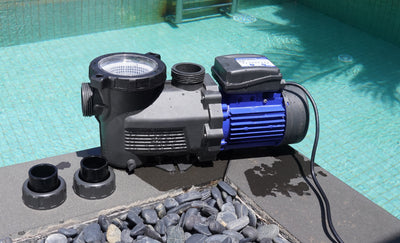How to Detect and Fix Pool Leaks: A Comprehensive Guide by AQUASTRONG
Finding a leak in your pool can be a stressful experience, but with the right tools and methods, you can detect and fix the problem yourself. Pool leaks can happen anywhere, whether in the pool structure, plumbing, or equipment. Before diving into the search, it's essential to rule out common issues like evaporation and plumbing cracks.
In this guide, we'll walk you through the steps to identify pool leaks and how to fix them using simple DIY methods.
Step 1: Determine if Your Pool is Losing Water or Just Evaporating
Before starting your search for leaks, it’s important to rule out evaporation as the cause of water loss. A quick way to do this is by performing a Bucket Test. This method is simple and requires just a few basic supplies:
- A 5-gallon plastic bucket
- Waterproof marker or duct tape
How to Perform the Bucket Test:
-
Place the Bucket: Set the empty bucket on the second step of your pool and fill it with water to match the pool’s water level. Mark the water level inside the bucket using the marker or duct tape.
-
Turn Off the Pump: To avoid any interference from water circulating, turn off your pool pump and any auto-refill devices.
-
Wait 24 Hours: Let the bucket and pool sit for 24 hours. Then, compare the water levels. If the water level in both the pool and the bucket drops equally, your pool is losing water due to evaporation. However, if the pool water drops lower than the water in the bucket, this indicates a leak.
-
Repeat with Pump On: To narrow down the source of the leak, repeat the test with the pump running. If the pool loses more water when the pump is on, the leak is likely within your pool’s filter system or plumbing.
Step 2: Conduct a Dye Test to Pinpoint the Leak
Once you've ruled out evaporation, you can use a Dye Test to identify the exact location of the leak. This method is especially effective for detecting leaks around pool walls, the floor, or near fittings.
What You’ll Need:
- Leak-finding dye (available online or at pool supply stores)
- Waterproof tape (optional for marking spots)
How to Perform the Dye Test:
-
Inspect the Pool: Check the ground and walls around the pool for wet areas, especially where there shouldn’t be any moisture. This will help you narrow down the possible location of the leak.
-
Turn Off the Pump: To ensure accurate results, turn off the pump and any water features to calm the water’s surface.
-
Apply the Dye: Squirt the leak-finding dye near the suspected leak area. If a leak is present, the dye will be drawn toward the crack or hole.
-
Mark the Spot: Once you’ve identified the leak, use waterproof tape to mark the spot for easier repair later. If the leak is at the bottom of the pool, you may need goggles to inspect the area closely.
Step 3: Fixing the Leak
Once you've pinpointed the leak, the next step is to fix it. For vinyl liner pools, the repair process is relatively straightforward and can be done without draining the pool.
Repair Methods for Vinyl Pool Liners:
-
Waterproof Tape: The simplest option, this clear, waterproof tape is UV-resistant and easy to apply. It works best for small leaks but may peel over time. It’s also easy to remove and reapply if needed.
-
Peel-and-Stick Patches: These vinyl patches are designed for pools and are available in round shapes, making them less prone to peeling. Simply peel off the backing and press the patch over the leak. This method works well for minor tears or punctures.
-
Vinyl Pool Liner Repair Kit: For larger holes, a vinyl repair kit that includes adhesive and a vinyl patch can offer a more long-term solution. These kits allow for precise application, but they require a bit more effort and skill than the tape or peel-and-stick patches.
Step 4: When to Call a Professional
If you’re dealing with a larger leak or suspect that it’s located underground, you might need to consult a professional. While DIY methods can solve many minor leaks, if you have an inground pool and the leak is suspected to be in the plumbing or under the pool, professional pressure testing will be necessary to detect cracks or damage underground.
Final Thoughts
While pool leaks can be frustrating, knowing how to perform leak detection and repair can save you time and money. Start by ruling out evaporation, then use the bucket test and dye test to identify the problem area. Once you’ve found the leak, patch it up using the appropriate method for your pool’s material. For more significant issues, don't hesitate to consult a professional.
At AQUASTRONG, we believe in making pool maintenance easier and more cost-effective. For expert advice and high-quality pool equipment, check out our range of products designed to keep your pool in top condition year-round.
Remember: Pool repairs don’t have to be daunting. With a little patience and the right tools, you can take care of most leaks yourself!

